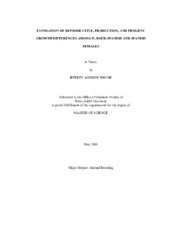| dc.description.abstract | The study was performed in the Edwards Plateau region of West Texas from the
years of 1994 through 2004 and involved data collected on 291 F1 Boer-Spanish and
Spanish does and their 1,941 kids. Differences were estimated between dam types for
growth traits, fertility traits, prolificacy, kid growth traits, survivability, longevity, and
progeny growth. The mixed model analysis of variance procedure was used for all traits,
except doe survivability where chi-square analysis was used.
The F1 Boer-Spanish does were significantly heavier at birth than Spanish does,
but there was no significant difference between the F1 Boer-Spanish and Spanish does
for weaning weight. The F1 Boer-Spanish does had a significantly heavier body weight
at breeding than the Spanish does (46 vs. 43 kg). No significant differences were found
between breed types for fertility traits. Age of doe was a significant source of variation
for fertility. There was no significant difference between the two doe breed types for
number of kids born or number of kids weaned. Age of doe significantly affected both
number of kids born and number of kids weaned. There was no significant differencebetween breed for total litter weight at weaning. For kid birth weight there was no
significant difference between dam breed types. Kid weaning weight and pre-weaning
average daily gain were not significantly different between dam breed types. Age at
time of leaving the herd for all causes was 6.15 years for F1 Boer-Spanish does and 5.56
years for Spanish does (P = 0.06). There was no significant difference between breeds
for proportions of does leaving the herd for the three main reasons.
Although F1 Boer-Spanish does were significantly heavier for birth weight and
body weight at breeding, there were no significant differences for weaning weights,
reproduction, production, and progeny growth differences at weaning between F1 Boer-
Spanish and Spanish does. When kid production was measured at weaning there was no
difference between breeds. However the greater body weight of the F1 Boer-Spanish
does at breeding suggests that if kid production was measured at a later endpoint, a
significant difference may be realized. | en |


